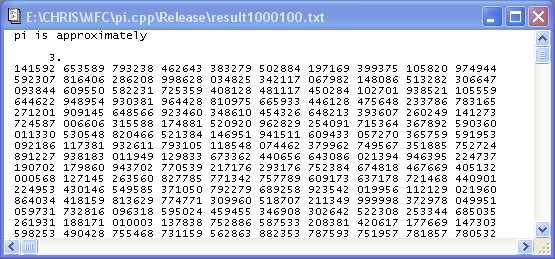
Introduction
Pi is one of the most important numbers in mathematics. It is defined as the ratio of a circle's circumference to its diameter, but it crops up in all sorts of places in mathematics. It is an infinitely long non-recurring decimal number.
I'm not going to try to write pi as the Greek letter  in this article, because some browsers might show it incorrectly.
in this article, because some browsers might show it incorrectly.
Calculating lots of digits of pi
There are many ways to do this. Some methods converge rapidly but are complicated to implement. Some are simple to implement but converge very slowly. I've chosen a method that is fairly simple and converges reasonably fast. It is based on the following formula:
pi / 4 = 4 * tan-1(1 / 5) - tan-1(1 / 239)
This is Machin's formula and is exact.
tan-1() is the Inverse Tangent function, and I use the Maclaurin series to calculate it:
tan-1(z) = z - z3 / 3 + z5 / 5 - z7 / 7 + ...
By including sufficiently many terms of this series, we can achieve any desired accuracy. To get 1,000,000 decimal places accuracy for pi, we need about 715,000 terms of the tan-1(1/5) series and about 210,000 terms of the tan-1(1/239) series, but this doesn't have to be worked out in advance, the attached program stops automatically when it determines that the required accuracy has been reached.
Multi-length arithmetic
A 32-bit integer only gives us about 9 significant digits. To get one million decimal places, I've done a simple implementation of the multi-length arithmetic operations that I need, using a big array of ints. The multi-length numbers are wrapped up inside the class CRHMultiLengthInteger. I've made full use of the operator notation in C++ to make the code look like we're just working with ordinary numbers. For example:
term5m /= n5 * 2 + 1;
looks like it's just dividing term5m by a number, but it's actually calling CRHMultiLengthInteger::operator /=().
The program
The attached program is a straightforward Win32 Console Application (it started out as the standard "Hello, World!" application with MFC support). You can adjust how many decimal places it calculates by changing #define NDecimalPlaces (1000100) to some other number. The answer is written to a file called resultNDecimalPlaces.txt.
Points of Interest
- The algorithm described above has an O(n2) duration. So 10 times as many decimal places will take about 100 times as long. My 7,000 MIPs PC took about 15 hours to calculate the first 1,000,000 decimal places of pi. That works out at about 380 million million instructions in total.
- To get 1,000,000 decimal places, each multi-length number is implemented as an array of 166685 integers, using a base of 1,000,000 so that each integer gives us 6 significant digits. This actually gives us 1,000,104 decimal places, but the last few might be incorrect because of the infinite number of terms of the Maclaurin series that we have to throw away. Comparison with this shows that the last three decimal places are wrong, so we have actually got pi correct to 1,000,101 decimal places.
- The first 1,000,000 decimal places of pi were first calculated in 1973.
- The 19th century English mathematician William Shanks spent over 15 years calculating the first 707 places of pi using Machin's formula. He published his results in 1873. In 1944 it was found that he had made a mistake in the 528th place, and all the following digits were wrong. By changing to
#define NDecimalPlaces (1000), you can now achieve in a fraction of a second more than William Shanks failed to achieve in 15 years.
Why?
This article is just for fun. I know it's pretty straightforward but I thought people might be interested in seeing it.
Getting a computer to calculate lots of digits of pi does have its uses, it can be used to show that the computer, or at least its ALU, is working properly.
Acknowledgments
Thanks very much to:
History
- 6th September 2005 - first submitted.
